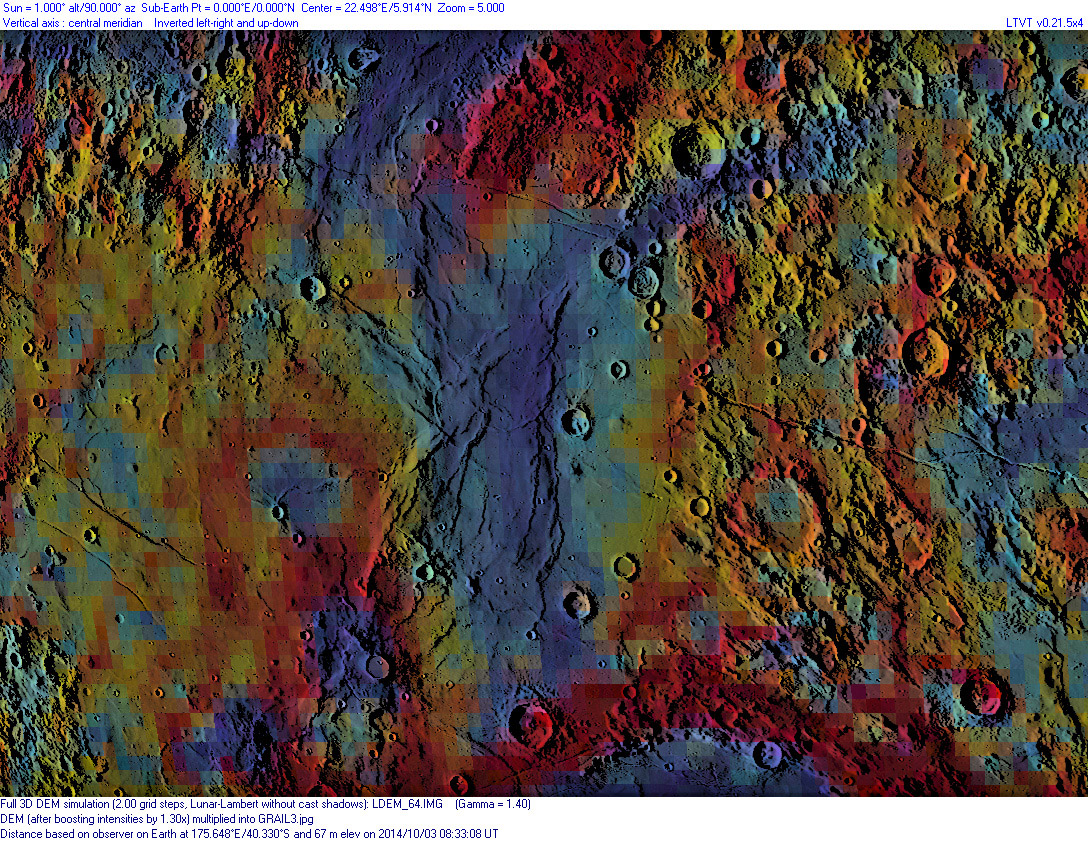Difference between revisions of "October 5, 2014"
| Line 6: | Line 6: | ||
<em>south up superposition of GRAIL gravity gradient map over LRO digital topography by [mailto:mauricejscollins@hotmail.com Maurice Collins], New Zealand</em><br /> | <em>south up superposition of GRAIL gravity gradient map over LRO digital topography by [mailto:mauricejscollins@hotmail.com Maurice Collins], New Zealand</em><br /> | ||
<br /> | <br /> | ||
| − | Quasi-linear positive gravity anomalies - I've called them [http://lpod. | + | Quasi-linear positive gravity anomalies - I've called them [http://www2.lpod.org/wiki/October_2,_2014 blue worms] - discovered by the GRAIL team are interpreted as buried [http://www.nature.com/nature/journal/v514/n7520/full/nature13697.html rift valleys full of high density lavas]. I noticed that one of the largest intensity worm cut through western Tranquillitatis, and asked Maurice if he could mash together the worm map and LRO altimetry so that we could see the surface manifestations of the worms. He did. We can. The most interesting correlation is that there is a high gravity anomaly - a wormcon? - passing right through Lamont. This enigmatic double ring system with massive mare ridges to the north and south has been generally interpreted as a small, double ring impact basin covered with later lavas of Mare Tranquillitatis. The existence of a small mascon over Lamont supported that interpretation, for many basins have mass concentrations in their centers. The much higher resolution GRAIL data show that the anomaly is strong at Lamont, but continues beyond it. This strongly suggests to me that Lamont is not a buried basin but is entirely a volcanic landform. Notice two other concentrations of deep blue near the bottom left of the image. The first is centered over the crater Jansen, the mound it sits upon, and the associated rille sources; I have [http://www2.lpod.org/wiki/October_28,_2009 previously] speculated that Jansen is a volcanic crater; now that seems even more likely. Even more pleasing to me is the second blue gravity anomaly closer to the bottom left corner. This anomaly coincides with the Gardner Megadome, a giant volcanic dome that I first [http://www.lpod.org/archive/LPOD-2004-09-26.htm recognized] ten years ago. The excellent correspondence of gravity highs with already suspected volcanic features makes even more likely the interpretation of Lamont as a volcano. It will be fascinating to look in detail at all the other high intensity blue worms. Notice, for example, that the Gutenberg Rilles at top left overlie a worm, but is there a volcanic association for the worm at top right that strikes across highlands material? This is going to be fun.<br /> |
<br /> | <br /> | ||
<em>[mailto:tychocrater@yahoo.com Chuck Wood]</em><br /> | <em>[mailto:tychocrater@yahoo.com Chuck Wood]</em><br /> | ||
| Line 12: | Line 12: | ||
<br /> | <br /> | ||
<strong>Related Links</strong><br /> | <strong>Related Links</strong><br /> | ||
| − | <em>[ | + | <em>[[21st Century Atlas of the Moon|21st Century Atlas]]</em> charts 7 & 8.<br /> |
<br /> | <br /> | ||
<p><b>Yesterday's LPOD:</b> [[October 4, 2014|Rover Trip]] </p> | <p><b>Yesterday's LPOD:</b> [[October 4, 2014|Rover Trip]] </p> | ||
Latest revision as of 08:36, 28 October 2018
A Can of Worms?

south up superposition of GRAIL gravity gradient map over LRO digital topography by Maurice Collins, New Zealand
Quasi-linear positive gravity anomalies - I've called them blue worms - discovered by the GRAIL team are interpreted as buried rift valleys full of high density lavas. I noticed that one of the largest intensity worm cut through western Tranquillitatis, and asked Maurice if he could mash together the worm map and LRO altimetry so that we could see the surface manifestations of the worms. He did. We can. The most interesting correlation is that there is a high gravity anomaly - a wormcon? - passing right through Lamont. This enigmatic double ring system with massive mare ridges to the north and south has been generally interpreted as a small, double ring impact basin covered with later lavas of Mare Tranquillitatis. The existence of a small mascon over Lamont supported that interpretation, for many basins have mass concentrations in their centers. The much higher resolution GRAIL data show that the anomaly is strong at Lamont, but continues beyond it. This strongly suggests to me that Lamont is not a buried basin but is entirely a volcanic landform. Notice two other concentrations of deep blue near the bottom left of the image. The first is centered over the crater Jansen, the mound it sits upon, and the associated rille sources; I have previously speculated that Jansen is a volcanic crater; now that seems even more likely. Even more pleasing to me is the second blue gravity anomaly closer to the bottom left corner. This anomaly coincides with the Gardner Megadome, a giant volcanic dome that I first recognized ten years ago. The excellent correspondence of gravity highs with already suspected volcanic features makes even more likely the interpretation of Lamont as a volcano. It will be fascinating to look in detail at all the other high intensity blue worms. Notice, for example, that the Gutenberg Rilles at top left overlie a worm, but is there a volcanic association for the worm at top right that strikes across highlands material? This is going to be fun.
Chuck Wood
This image also shows that the two sides of Tranquillitatis are totally different structurally.
Related Links
21st Century Atlas charts 7 & 8.
Yesterday's LPOD: Rover Trip
Tomorrow's LPOD: Peaked
COMMENTS?
Register, Log in, and join in the comments.



